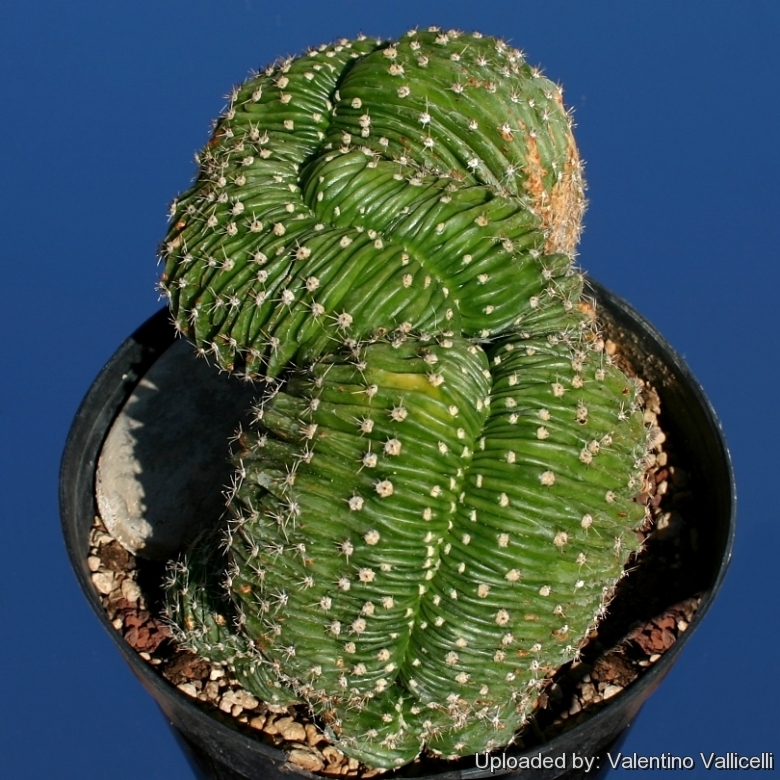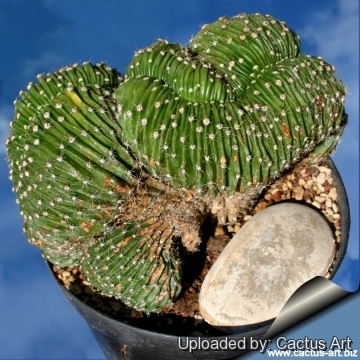Accepted Scientific Name: Echinopsis eyriesii (Turpin) Pfeiff. & Otto
Abbild. Beschr. Cact. i. sub t. 4.1839 Pfeiff.

Echinopsis eyriesii var. cristata Photo by: Valentino Vallicelli
Origin and Habitat: Garden origin. The natural species is native to Southern Brazil, Uruguay, and province of Entre Rios, Argentina where it grows in grassy plains or in low hills in lowland up to to 1000 metres above sea levels. The climate is tropical, continental. Winter are completely dry, while in summer the landscape is flooded by torrential rain and soaked with water. Rainfall up to 1500 mm per annum. Average annual temperature 25-30 ° C. Rarely the temperature drop below zero degrees even if the landscape is open to the cold south pamperos winds.
Synonyms:
See all synonyms of Echinopsis eyriesii
back
Accepted name in llifle Database:Echinopsis eyriesii (Turpin) Pfeiff. & OttoAbbild. Beschr. Cact. i. sub t. 4.1839Synonymy: 35
back
Common Names include:
ENGLISH: Crested Easter Lily Cactus, Crested Sea Urchin Cactus
Description: Echinopsis eyriesiiSN|17377]]SN|8004]] is a very popular large caespitose cactus, widely grown for the huge nocturnal flowers. It is the best known and most commonly grown globular cactus.
Crested form: The crested form (Echinopsis eyriesii var. cristataSN|8004]]SN|25315]]) is a fast-growing and robust crested cactus forming brain shaped mounds. Exceptionally in time it may forms large mounds up to 1 m tall and 2 m wide.
Root: Fibrous.
Stem: Fan shaped, 15-30 cm high, 12 to 15 cm thick, dark green and ribbed.
Ribs: 9 to 18, not tuberculate, prominent, rather thin above.
Areoles: Circular, filled with white or tawny wool up to 1 cm apart.
Spines: Several, 14 to 18, very short.
Radial spines: Thin 5-10 mm long often missing in adult specimens.
Central spines: 4-8 thick, conical, less than 5 mm tall, hard, blackish. Young plants and offshoot initially have longer and weaker spines, the stout short conical spines appear only later.
Flower: Nocturnal, pure white, very large, from the side of plant but above the middle, 17 to 25 cm long, 5-10 cm in diameter (The presence of pink shades in the flower shows hybridization). Floral tube funnel-shaped with a strong basal part underlying the ovary, then narrow and variously curved and gradually extending into the crown, dark green covered with small, ovate, brownish scales and dark grey to black hair. Lower outer perianth segments, rather linear and greenish, inner perianth-segments broad and white, acuminate. Throat greenish, with several several stamens around the inner perimeter. Stamens and style shorter than the perianth-segments. Flowers are intensely fragrant.
Blooming season: Flowers appears from spring to summer in several flush at night. In sunny weather the next day they fade, but in cold, rainy weather they may last two, rarely three days.
Fruit: Up to 5 cm long, green, covered with hairs and containing a large number of black seeds.
Remarks: Echinopsis eyriesiiSN|8380]]SN|8004]] is strictly related and forms a complex with Echinopsis oxygona, Echinopsis multiflora and Echinopsis multiplexSN|8004]]SN|8380]] (and their hybrids). All this species have the same elongated stem with sharp ribs and long funnel shaped flowers, but distinguish for the longer spines and the pink flowers usually unscented. Sometime Echinopsis eyriesiiSN|25315]]SN|8004]] is confused with Echinopsis subdenudataSN|8004]]SN|17377]] that has round (not elongated) stems with very large woolly areoles.
Subspecies, varieties, forms and cultivars of plants belonging to the Echinopsis eyriesii group
Bibliography: Major references and further lectures
1) Edward Anderson “The Cactus family” Timber Press, Incorporated, 2001
2) James Cullen, Sabina G. Knees, H. Suzanne Cubey "The European Garden Flora Flowering Plants: A Manual for the Identification of Plants Cultivated in Europe, Both Out-of-Doors and Under Glass" Cambridge University Press, 11/Aug/2011
3) David R Hunt; Nigel P Taylor; Graham Charles; International Cactaceae Systematics Group. "The New Cactus Lexicon" dh books, 2006
4) N. L. Britton, J. N. Rose “The Cactaceae. Descriptions and Illustrations of Plants of the Cactus Family.” Volume 4, The Carnegie Institution of Washington, Washington 1923
5) Curt Backeberg “Die Cactaceae: Handbuch der Kakteenkunde” Gustav Fischer Verlag, Stuttgart New York 1982–1985
6) John Borg “Cacti: a gardener's handbook for their identification and cultivation” Blandford P., 1970
7) Arthur Gibson, Park Nobel “The cactus primer” Harvard University Press, 01/Oct/1990
8) Hecht, “BLV Handbuch der Kakteen” BLV Verlagsgesellschaft mbH, München
9) Erik Haustein “Der Kosmos-Kakteenführer” Balogh Scientific Books 1998
 Echinopsis eyriesii var. cristata Photo by: Cactus Art
Echinopsis eyriesii var. cristata Photo by: Cactus Art Echinopsis eyriesii var. cristata Photo by: Cactus Art
Echinopsis eyriesii var. cristata Photo by: Cactus ArtCultivation and Propagation: Crested growth: Unlike 'monstrous' varieties of plants, where the variation from normal growth is due to genetic mutation, crested growth can occur on normal plants. Sometimes it's due to variances in light intensity, or damage, but generally the causes are unknown. A crested plant may have some areas growing normally, and a cresting plant that looks like a brain, may revert to normal growth for no apparent reason. If you have any of the crested part left you need to remove the normal growth and leave the crested part behind this will need to be done regularly.












